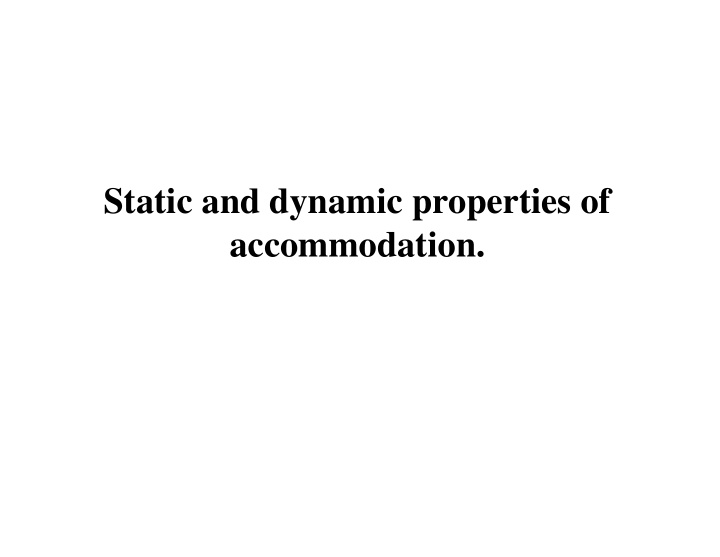



Static and dynamic properties of accommodation.
Maddox components (response categories) of accommodation: From “The clinical use of prisms” 1) Tonic- 1.5 D bias: Intrinsic baseline bias or balance point between autonomic inputs (sympathetic & parasympathetic). Manifest as the myopias (night, space, & instrument) Adaptable bias = accommodative spasm 2) Proximal - response to perceived distance 3) Optical reflex - response to defocus magnitude (even error signal) direction (odd error signal) 4) Convergence-accommodation cross-link with convergence guides accommodation
3 Factors Contributing to Night Myopia aka Dark Focus Tonic Accommodation: Increased parasympathetic mostly due to empty field Spherical Aberration: from large dilated pupils Chromatic aberration and the ROYGBV Purkinje Shift in spectral sensitivity with dark adaptation
Chromatic aberration,blur circles and error of accommodation Zero error Over accommodation: Myopic Lead Under accommodation: Hyperopic Lag- A clinical application is the Duochrome test
Duochrome Test Hyperopia Myopia clearer clearer
1) Space Myopia: AKA Empty field myopia- pilot problem Blur or fog myopia- clinician problem with plus balance refractive technique 2) Instrument Myopia Perceived near distance of enlarged images stimulates too much proximal accommodation. 3) Tonic Accommodation is adaptable Accommodative Spasm Myopia: Neural adaptive response to prolonged near work.
Proximal accommodation responds to perception of distance during large voluntary shifts of attention ( Coarse adjustment ). Initial accommodation response to distance that is refined later by an optical reflex accommodation response to defocus. Most accommodation is a proximal response
Optical Reflex Accommodation (fine adjustment) Even error signals- amount of defocus- contrast loss Odd error signals- sense the direction for optical reflex (defocus driven) accommodation. Chromatic aberration- not consciously seen Astigmatism (with the rule) Temporal hunting cycle (2Hz)
Odd-error chromatic aberration Direction cue to accommodation Zero error Over accommodation: Lead Under accommodation: Lag-
Temporal Frequency Spectrum for Accommodative Nystagmus Trial and error hunting cycle to sense the correct direction to accommodate.
Convergence Accommodation (next lecture) Dynamics of accommodation
Dynamics of Accommodation : Latency (300 ms) & response time (1 sec)
Saccades increase the velocity of accommodation and shorten latency �� ���� � ���� � �� ���� � ���� � �� �� � ��� �� �� � � � �� ��� � � ��� � � � �� ��� � � ��� � �� � ��� � � �� ��� � � � � �� ��� � �� ��� ���� � ��� ��� ��� ��� ��� ��� ��� ��� ��� ��� ���� � ��� ��� ��� ��� ��� ��� ��� ��� ��� ��� � � �� �� � � � � ��� �� � �� � � �� ��� � � ��� � ��� " � �� � ��� � ! �� � � � �� ��� ��� � � ��� �� � � � �� � ��� ���� � ��� ��� ��� ��� ��� ��� ��� ��� ��� ��� ���� � ��� ��� ��� ��� ��� ��� ��� ��� ��� ��� #��� $%���&�%'
Accommodation smooth tracking ability. Prediction reduces time lags.
Consensual Accommodation demonstrated by effect of Cycloplegia on Yoked Accommodation Target moves in Normally, a covered eye will accommodate just like the viewing eye If viewing eye is cyclopleged, then Target moves in covered eye makes excessive response, driven by increased effort to accommodate.
Differential Accommodation in Asymmetric Viewing E E Consensual Accom Differential Accom Near objects off to the side are closer to one eye than the other, requiring different amounts of accommodation in each eye to be simultaneously clear.
Laboratory #1 Accommodation stimulus-response function . Questions to think about during the laboratory exercise: How accurate is accommodation? What is the error (lag) of accommodation? What optical factors influence the magnitude of the error? How accurate are your clinical measures of refractive error? What clinical techniques bias the error of accommodation?
Lead & Lag of Accommodation A Depth of Field causes A and B (and all states in between) to look the same B Far targets usually focus in front of retina (lead produced by refractive correction + bias) C Near targets usually focus behind retina (lag) D
Depth of Focus
Accommodative Response Function
Chief ray limits retinal image size for all viewing distances Nagal Optometer Badal Optometer
Haploscope
Measuring Accommodation with Badal Optometer-Stigmascope Half-silvered mirror (beam splitter) 8D Badal lens Spectacle Plane +3 = Anterior focal point of eye +2 = secondary focal point of Badal lens Adjustable Stigma +1 with Diopter scale 0 -1 Newton’s Lensmakers equation: P 2 = 1/(x *x’) x= distance between object and primary focal point Solve for X’
Calculate the accommodative stimulus (AS) and accommodative response (AR) relative the the spectacle plane. AS = 1/Td – (L + RE) AR= CF – (L + RE) CF= P – (SD x P 2 ) = 10 –(SDm x 100) or 8- (SDx64) Td= target distance from the spectacle plane (Badal secondary focal pt) RE= refractive error Myopia (+ error) Hyperopia (– error) SD= Stigma distance to the Badal lens L= Spectacle lens power P= Badal lens power
Calculate the accommodative stimulus (AS) and accommodative response (AR) Td= 0.14 M RE= zero Myopia (+ error) Hyperopia (– error) SD= 4 cm = .04 M L= - 3D P= 10D AS = 1/Td – (L + RE) = 7 – (-3 + 0) = 10D CF= P – (SDm x P 2 ) = 10 – (.04 x 100) = 6D or 8 – (.03 x 64)= 6D AR= CF – (L + RE) = 6 – (-3 + 0)= 9D There is a 1D lag of accommodation (10D-9D)
Conjugate Points
Recommend
More recommend